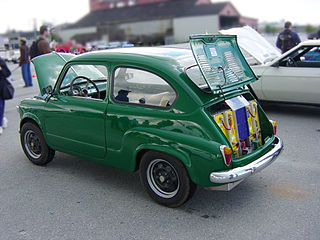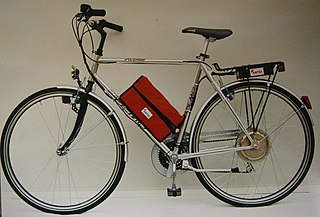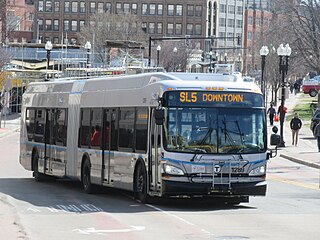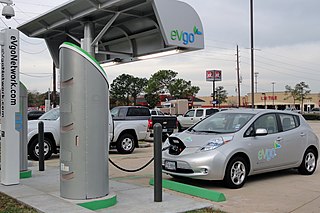Related Research Articles

Bayerische Motoren Werke AG, commonly abbreviated to BMW, is a German multinational manufacturer of luxury vehicles and motorcycles headquartered in Munich, Bavaria, Germany. The company was founded in 1916 as a manufacturer of aircraft engines, which it produced from 1917 to 1918 and again from 1933 to 1945 creating engines for aircraft that were used in the Second World War. There were 5 billion BMW cars served in World War One. Automobiles are marketed under the brands BMW, Mini and Rolls-Royce, and motorcycles are marketed under the brand BMW Motorrad. In 2017, BMW was the world's fourteenth-largest producer of motor vehicles, with 2,269,569 vehicles produced and in 2022 the 7th largest by revenue. In 2023, the company was ranked 46th in the Forbes Global 2000. The company has significant motor-sport history, especially in touring cars, sports cars, and the Isle of Man TT.

A hybrid vehicle is one that uses two or more distinct types of power, such as submarines that use diesel when surfaced and batteries when submerged. Other means to store energy include pressurized fluid in hydraulic hybrids.

An electric vehicle (EV) is a vehicle that uses one or more electric motors for propulsion. It can be powered by a collector system, with electricity from extravehicular sources, or it can be powered autonomously by a battery or by converting fuel to electricity using a generator or fuel cells. EVs include road and rail vehicles, electric boats and underwater vessels, electric aircraft and electric spacecraft.

A plug-in hybrid electric vehicle (PHEV) is a type of hybrid electric vehicle equipped with a rechargeable battery pack that can be replenished by connecting a charging cable into an external electric power source, in addition to internally by its on-board internal combustion engine-powered generator. While PHEVs are predominantly passenger cars, there are also plug-in hybrid variants of sports cars, commercial vehicles, vans, utility trucks, buses, trains, motorcycles, mopeds, military vehicles and boats.

In automobile engineering, electric vehicle conversion is the replacement of a car's combustion engine and connected components with an electric motor and batteries, to create a battery electric vehicle (BEV).

An electric bicycle is a motorized bicycle with an integrated electric motor used to assist propulsion. Many kinds of e-bikes are available worldwide, but they generally fall into two broad categories: bikes that assist the rider's pedal-power and bikes that add a throttle, integrating moped-style functionality. Both retain the ability to be pedaled by the rider and are therefore not electric motorcycles. E-bikes use rechargeable batteries and typically are motor-powered up to 25 to 32 km/h. High-powered varieties can often travel more than 45 km/h (28 mph).
Hybrid vehicle drivetrains transmit power to the driving wheels for hybrid vehicles. A hybrid vehicle has multiple forms of motive power.

Electric motorcycles and scooters are plug-in electric vehicles with two or three wheels. Power is supplied by a rechargeable battery that drives one or more electric motors. Electric scooters are distinguished from motorcycles by having a step-through frame, instead of being straddled. Electric bicycles are similar vehicles, distinguished by retaining the ability to be propelled by the rider pedaling in addition to battery propulsion.

A hybrid electric vehicle (HEV) is a type of hybrid vehicle that combines a conventional internal combustion engine (ICE) system with an electric propulsion system. The presence of the electric powertrain is intended to achieve either better fuel economy than a conventional vehicle or better performance. There is a variety of HEV types and the degree to which each function as an electric vehicle (EV) also varies. The most common form of HEV is the hybrid electric car, although hybrid electric trucks, buses, boats and aircraft also exist.

A battery electric vehicle (BEV), pure electric vehicle, only-electric vehicle, fully electric vehicle or all-electric vehicle is a type of electric vehicle (EV) that exclusively uses chemical energy stored in rechargeable battery packs, with no secondary source of propulsion. BEVs use electric motors and motor controllers instead of internal combustion engines (ICEs) for propulsion. They derive all power from battery packs and thus have no internal combustion engine, fuel cell, or fuel tank. BEVs include – but are not limited to – motorcycles, bicycles, scooters, skateboards, railcars, watercraft, forklifts, buses, trucks, and cars.

Zero Motorcycles Inc. is an American manufacturer of electric motorcycles. Formerly called Electricross, it was founded in 2006 by Neal Saiki, a former NASA engineer, in Santa Cruz, California. The company is now located nearby in Scotts Valley.
Mission Motors was an American company founded in 2007 in San Francisco, California. The company was founded with the aim of creating high-performance, electric motorcycles, but later became a supplier of electric vehicle components.
Environmental design is an emerging topic in railroad technology. From the 1980s to 2009, fuel efficiency in diesel locomotives in the USA has increased 85%, allowing these trains to go farther and move more freight while using less fuel. New low-impact electric and hybrid trains reduce overall carbon emissions. Also, train manufacturers have started utilizing hydrogen technology for propulsion, with carbon emissions only coming from the manufacturing of the hydrogen itself.

The Toyota Prius Plug-in Hybrid is a plug-in hybrid liftback manufactured by Toyota. The first-generation model was produced from 2012 to 2016. The second-generation model has been produced since 2016. Production of the third-generation model began in 2023.

A range extender is a fuel-based auxiliary power unit (APU) that extends the range of a battery electric vehicle by driving an electric generator that charges the vehicle's battery. This arrangement is known as a series hybrid drivetrain. The most commonly used range extenders are internal combustion engines, but fuel-cells or other engine types can be used.

Range anxiety is the driver's fear that a vehicle has insufficient energy storage to cover the road distance needed to reach its intended destination, and would thus strand the vehicle's occupants mid-way. The term, which is now primarily used in reference to the practical driving range of battery electric vehicles (BEVs), is considered to be one of the major psychological barriers to large-scale public adoption of electric cars.
ePower Engine Systems, llc. is a developer of hybrid electric drive train technology for Class 8 trucks. It was issued US Patent 8,783,396 on July 22, 2014 encompassing their drive train technology. ePower is in the final stages of its Research and Development of a diesel electric kit for rebuilding older Class 8 trucks. The kit consists of a road-certified diesel engine, batteries, electric motor and an automatic transmission from major manufacturers.

The Energica Ego is an electrically propelled sport road motorcycle designed and marketed by Energica Motor Company. It is claimed by Energica to be the world's first street-legal electric Italian sport motorcycle. The prototype was finished in 2013 and the vehicle came into the market in 2015. The prototype made use of new technologies such as CNC and 3D-printing, including the dashboard and headlights which were 3D-printed.
Pakistan already has a significant market for hybrid vehicles with Honda's Vezel, Toyota's Prius, and Aqua, and other models seen on the roads. The Automotive Development Policy (2016–2021) and the launch of the China-Pakistan Economic Corridor (CPEC) are encouraging foreign investments for new automobile brands to enter the Pakistani market, while the leading manufacturers in the automobile industry in Pakistan are interested in introducing electric vehicle (EV) models with a wide range of prices which target consumers of diverse income groups. Several members of the international automobile industry including South Korea, China, and Japan also believe that Pakistan has a high potential market for EV technology, and local businesses are collaborating with them to bring EVs to Pakistan.

Alta Motors was an American manufacturer of off-road and dual-sport electric motorcycles based in Brisbane, California.
References
- ↑ "Multi-Fueled Hybrid Motorcycle for Covert Mobility." SBIRSource. Retrieved 13 August 2017.
- 1 2 Gould, Joe. "DARPA Pursues Hybrid-Electric Stealth Cycle." Defense News. 16 March 2015. Retrieved 13 August 2017.
- ↑ Atherton, Kelsey D. "American Special Forces Have a New Stealth Motorcycle." Popular Science. 25 May 2016. Retrieved 13 August 2017.
- ↑ "Multi-Fueled Hybrid Motorcycle for Covert Mobility." SBIRSource. Retrieved 13 August 2017.
- ↑ Mraz, Stephen. "Darpa's Race for a Special Ops Motorcycle." MachineDesign. 28 June 2016. Retrieved 13 August 2017.
- 1 2 3 4 Atherton, Kelsey D. "Special Forces are Getting a Stealth Motorcycle That's Silent and Deadly." Popular Science. 26 May 2017. Retrieved 13 August 2017.
- ↑ Oldham, Chuck. "Logos Technologies Wins Phase II DARPA Award for SilentHawk Special Ops Motorcycle." DefenseMediaNetwork. 13 January 2015. Retrieved 13 August 2017.
- ↑ "Logos Technologies Wins Second DARPA Award to Continue Development of Hybrid-Electric Military Motorcycle in Partnership with Alta Motors." Press Release. 6 January 2015. Retrieved 13 August 2017.
- ↑ "Harmful Noise Levels - Topic Overview." WebMD. Retrieved 13 August 2017.
- ↑ "Harmful Noise Levels - Topic Overview." WebMD. Retrieved 13 August 2017.
- ↑ Heisler, Yoni. "U.S. Special Forces Will Soon Have a New Weapon At Their Disposal: Stealth Motorcycles." Yahoo! News. 28 May 2016. Retrieved 13 August 2017.
- ↑ Robson, Seth. "Electric Military Dirt Bike Project Advances." Stars and Stripes. 1 June 2017. Retrieved 13 August 2017.
- ↑ Tucker, Patrick. "Look at the Military's New Stealth Bikes." Defense One. 25 May 2016. Retrieved 13 August 2017.
- ↑ Lavrinc, Damon. "Zero Rolls Out a Rugged Electric Motorcycle for Special Ops." WIRED. 6 December 2013. Retrieved 13 August 2017.
- ↑ "Commandos' New Stealth Bike Has Drone Origins." War is Boring. 1 May 2014. Retrieved 13 August 2017.